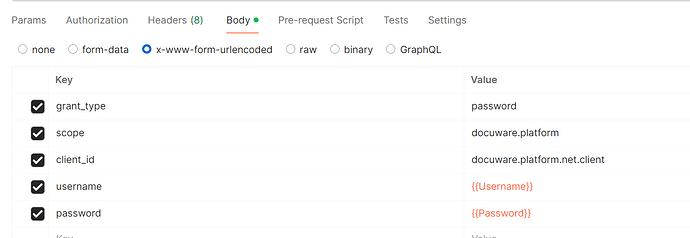Hello,
I am trying to build the connection to Docuware. It uses the OAuth2.0, grant type password, sent in request as http body which is x-www-form-urlencoded.
In Postman I've successfully tested the request with http header Content-Type: application/x-www-form-urlencoded and parameters set as on a below screenshot and retrieved the access_token in a response from token URL.
The access token response in Postman looks like this, with the valid access token:
{
"access_token": "{{accesstoken}},
"expires_in": 3600,
"token_type": "Bearer",
"scope": "docuware.platform"
}
In Celigo I defined OAuth2.0 iClient with the same token URL and overriden the request body as JSON:
My override http body in Celigo:
{
"grant_type": "password",
"scope": "docuware.platform",
"client_id": "docuware.platform.net.client",
"username": "{{{iClient.oauth2.username}}}",
"password": "{{{iClient.oauth2.password}}}"
}
In Celigo I tried to set the connector with access_token path specified and also without (as suggested by Celigo - this response is default format so parser is pre-set to retrieve the token automatically).
For the application API requests the token should be in Authorization header as Bearer, what I have also set.
But somehow when I see the Celigo application request header it looks like this in the end, so I am not able to authorize for Docuware web services:
Possible error cause are IMHO these two points:
Authorization fails on retrieving access token
OR
Access token is retrieved, but Celigo is not able to parse it from the response.
My connection says it is Online, with a green indicator, but I don't know which level of connection this actually represents.
I am not able to see any detail or logs of the OAuth 2.0 authorization step to retrieve token so I don't know how to troubleshoot this. No Auth step response visible in Celigo.
Could anyone help me, please? I am lost...:(
Thank you for any advise!




